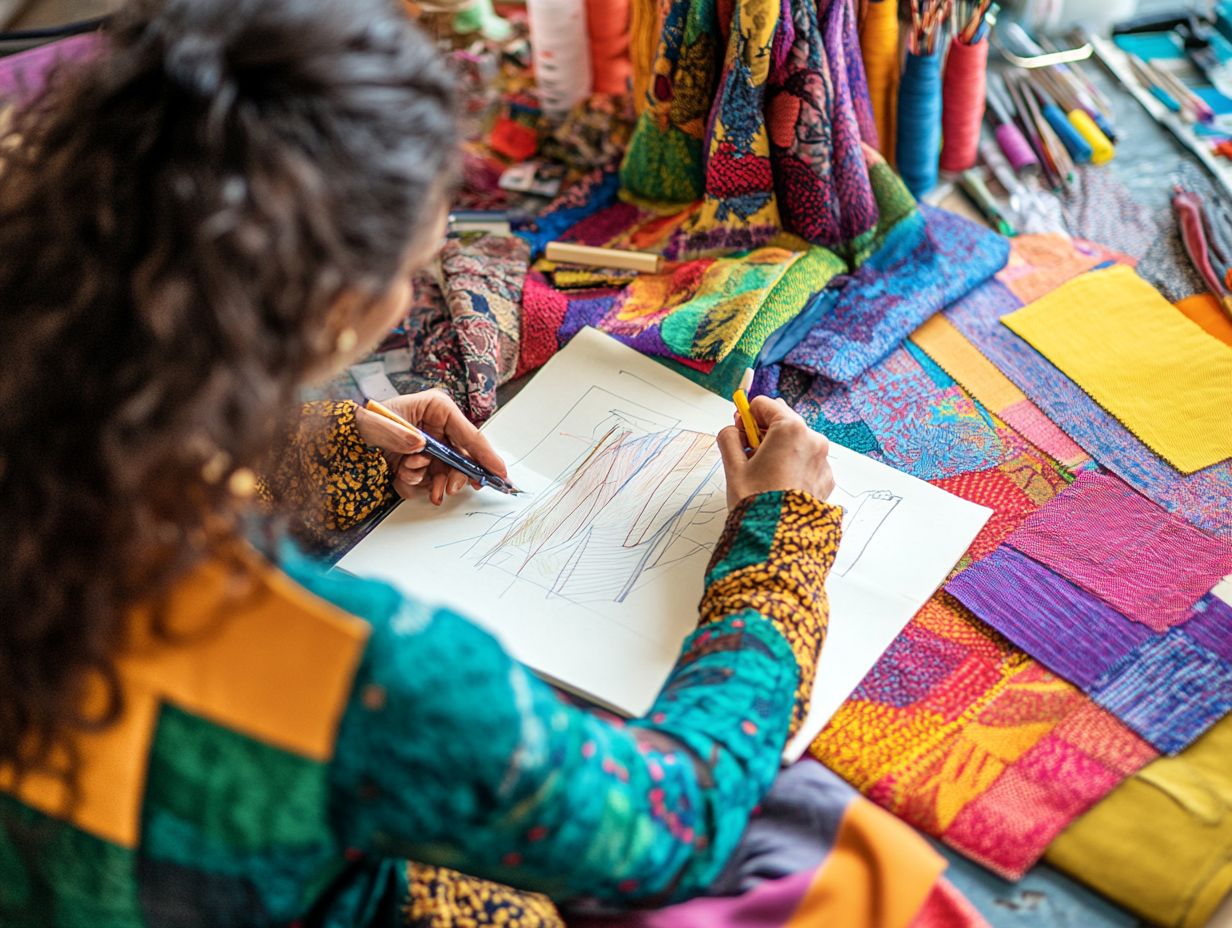The Role of Copyright in the Fashion Industry
In the fast-paced and ever-evolving world of fashion, protecting your unique designs is crucial if you want to stand out. Copyright serves as a vital shield, preserving the originality and uniqueness of your fashion works, whether they are garments or accessories.
This article delves into the essentials of copyright, the specific laws that govern the fashion industry, and the types of designs eligible for protection. You’ll uncover real-world examples of copyright infringement, alongside strategies to defend your creations and insights into emerging trends that could influence the future of copyright in fashion.
Whether you’re a designer, an entrepreneur, or simply a fashion enthusiast, grasping these concepts will empower you to navigate the complexities of copyright within this dynamic field.
Contents
- Key Takeaways:
- The Basics of Copyright
- Copyright Laws in the Fashion Industry
- Protection of Fashion Designs
- Copyright Infringement in the Fashion Industry
- Strategies for Protecting Your Fashion Designs
- The Future of Copyright in Fashion
- Frequently Asked Questions
- What is the role of copyright in the fashion industry?
- How does copyright protect the fashion industry?
- What types of fashion designs are protected by copyright?
- How long does copyright protection last for fashion designs?
- What happens if someone infringes on a fashion designer’s copyright?
- Are there any limitations to copyright protection in the fashion industry?
Key Takeaways:

Copyright provides legal protection for original fashion designs, including clothing, jewelry, and accessories.
Copyright laws in the fashion industry are constantly evolving and vary by country, making it important for designers to understand and comply with regulations.
To protect their designs from infringement, fashion designers should consider registering their designs with the appropriate authorities and taking precautionary measures, such as including copyright notices and monitoring for potential infringements.
Take these insights and empower your designs today!
The Basics of Copyright
Copyright holds significant importance in the realm of intellectual property law, serving as a shield for original works of creative expression. This legal framework grants creators, including fashion designers, exclusive rights to their intellectual property, allowing them to maintain control over the use of their creations.
For you as a fashion industry professional, understanding copyright law is essential to protecting your unique designs and brand identity. This is especially important in an era rife with challenges such as digital piracy and copyright infringement.
Definition and Purpose
Copyright law serves as a robust legal framework designed to protect your rights over your original creations. It ensures that your creative expression remains yours and cannot be used without your explicit permission.
This system not only safeguards the artistic and intellectual endeavors of authors, musicians, and artists like you but also cultivates an environment ripe for innovation to thrive.
By granting you exclusive rights, copyright law encourages you to invest your time and resources into your projects. Ultimately, this enriches the cultural landscape around you.
As a vital component of intellectual property, it gives you the power to maintain control over your ideas and creations.
In essence, this legal protection nurtures your creativity, allowing a diverse array of expressive works to flourish and inspiring further exploration in both the arts and sciences.
Copyright Laws in the Fashion Industry
Copyright laws are crucial in the fashion industry, defining how original designs receive protection and helping you understand trademark protection and your rights as a creator.
The Lanham Act, along with various U.S. Supreme Court rulings, has significantly influenced the landscape of fashion law.
These guidelines help fashion designers and luxury brands safeguard their creations from infringement and unauthorized use.
Overview of Relevant Laws and Regulations
An overview of the relevant laws and regulations in the fashion industry reveals that fashion law encompasses a variety of statutes, including copyright laws and the Lanham Act. Both are crucial for safeguarding original designs.
These legal frameworks protect the creativity and innovation that fuel the industry, allowing designers to defend their unique creations from unauthorized reproduction. The realm of trademark protections also plays an essential role, shielding brand names and logos to preserve the identity and reputation of fashion houses.
The Federal Trade Commission keeps a watchful eye on advertising practices in the fashion sector, enforcing regulations that promote transparency and honesty in marketing claims.
Together, these laws form a robust blueprint for maintaining fair competition while nurturing an environment where artistic expression can flourish.
Understanding these laws is vital now more than ever to stay ahead in the competitive fashion landscape.
Protection of Fashion Designs

The protection of fashion designs is crucial for designers and brands. It often requires a strategic use of legal protections for your creative work, including copyright and design patents, to safeguard original creations.
Renowned designers like Vera Wang, along with luxury brands such as Prada and Givenchy, understand the importance of this investment. By actively safeguarding their designs, they ensure a competitive edge in the ever-evolving fashion landscape.
Types of Designs Eligible for Copyright
Not every design qualifies for copyright protection. However, if you create original designs that exhibit artistic expression, you may find favorable opportunities especially if they aren’t classified as useful articles.
Understanding this distinction is key for aspiring fashion designers. For instance, an artistic design featuring a unique fabric pattern evokes a strong visual response, while useful articles are items intended for practical use, like a basic t-shirt or a handbag designed solely for carrying essentials.
To qualify for protection, your design must display creativity that transcends functionality. This contributes meaningfully to the aesthetic landscape of the industry. High-profile cases involving iconic sneakers or couture garments illustrate the delicate balance between utility and artistic innovation.
Copyright Infringement in the Fashion Industry
Copyright infringement presents considerable challenges in the fashion industry, especially if you represent a luxury brand investing significant resources into original designs. Unauthorized use of your creations can lead to hefty financial losses and dilute your brand’s identity.
With the surge of digital piracy and the omnipresence of online platforms, navigating these obstacles is increasingly complex. You must understand your rights and the repercussions of infringement to protect your creative investments.
Examples and Consequences
Several landmark cases vividly illustrate the consequences of copyright infringement in fashion, showcasing the legal risks when original designs are copied or misappropriated.
For example, the highly publicized case involving Christian Louboutin underscored the complexities of trademarking specific design elements. In this case, Louboutin successfully secured the right to protect his iconic red sole.
The allegations surrounding Zara’s copying of designs from Rodarte sparked discussions about the fine line between inspiration and imitation. These examples highlight that while the fashion world thrives on trends and reinterpretation, navigating a treacherous legal landscape is essential if your work is infringed upon.
Understanding these legal nuances is crucial for creators like you to protect your intellectual property and maintain your unique identity in an increasingly competitive industry.
Strategies for Protecting Your Fashion Designs
Act now to protect your fashion designs and secure your creative future! Implement comprehensive strategies covering multiple facets of intellectual property rights, such as copyright, trademark protection, and compliance with fashion law.
By gaining a deep understanding of the legal mechanisms at your disposal, you can safeguard your original creations from infringement and unauthorized use.
With the right strategies, you can confidently navigate the fashion industry and preserve your unique voice. Don t wait start protecting your designs today!
Steps to Take to Safeguard Your Work

Safeguarding original designs requires proactive measures under fashion law, including registering works for copyright and pursuing trademark protection for brand identity.
To ensure creations are shielded from unauthorized use, it s crucial to understand the basics of intellectual property rights. Start by documenting your design process, including sketches and prototypes. This evidence plays a pivotal role in asserting claims of ownership.
Filing for copyright secures exclusive rights to artistic works, preventing others from reproducing them without consent. Pursuing trademark registration for logos and brand names establishes a unique identity that sets designers apart in a competitive marketplace.
By implementing these strategies, designers can fortify their legal standing and protect their innovative contributions to the industry.
The Future of Copyright in Fashion
The future of copyright in fashion is influenced by emerging technologies, sustainability trends, and challenges posed by digital piracy.
This landscape compels designers and brands to adapt strategies to safeguard intellectual property rights effectively.
As the fashion industry evolves, understanding how these factors impact copyright law will be essential for maintaining a competitive edge.
Emerging Trends and Challenges
Emerging trends in sustainability and the rise of digital piracy pose unique challenges for designers in the fashion industry. This compels them to rethink approaches to copyright and intellectual property protection.
As designers prioritize eco-friendly materials and ethical production methods, they face the dilemma of how to protect innovative designs while maintaining a commitment to transparency.
The influence of social media accelerates the pace at which fashion trends can be copied. This results in rampant digital piracy that undermines the hard work of original creators.
This struggle makes enforcing copyright laws even tougher and sparks important discussions about fair use and the blurred lines between inspiration and imitation in the ever-evolving fashion landscape.
Frequently Asked Questions
What is the role of copyright in the fashion industry?
Copyright plays a crucial role in protecting original designs and creations of fashion designers, brands, and businesses. It ensures that work is not copied or used without permission, providing legal protection and recognition for intellectual property.
How does copyright protect the fashion industry?

Copyright laws give fashion designers and brands exclusive rights to their designs. This prevents others from using, selling, or profiting from original work without permission, helping maintain integrity and value in the market.
What types of fashion designs are protected by copyright?
Original and unique designs, such as clothing, accessories, patterns, and prints, can be protected by copyright. This includes both physical and digital designs, as well as sketches and illustrations.
How long does copyright protection last for fashion designs?
In most countries, copyright protection for fashion designs lasts for the lifetime of the creator plus an additional 70 years after death. Check your country s specific laws, as they may differ.
What happens if someone infringes on a fashion designer’s copyright?
If someone uses or copies a fashion designer’s original work without permission, it is considered copyright infringement and can lead to legal action. This includes both intentional and unintentional infringement, potentially resulting in penalties, fines, or damages to the designer’s business.
Are there any limitations to copyright protection in the fashion industry?
While copyright laws offer protection for original fashion designs, there are limitations. For example, functional items, such as plain t-shirts or basic jeans, may not be protected by copyright as they are considered utilitarian. Additionally, copyright does not protect against ideas or concepts, only the specific expression or design itself.
Act now to protect your designs and stand out in a crowded market!






